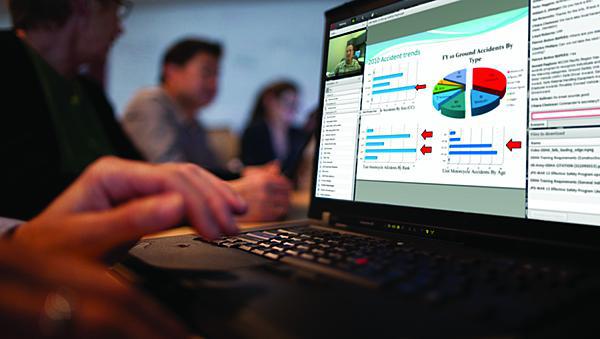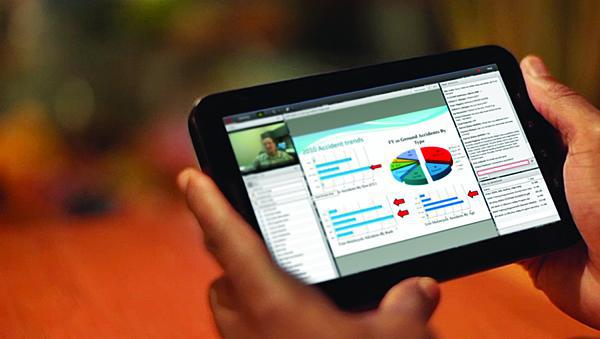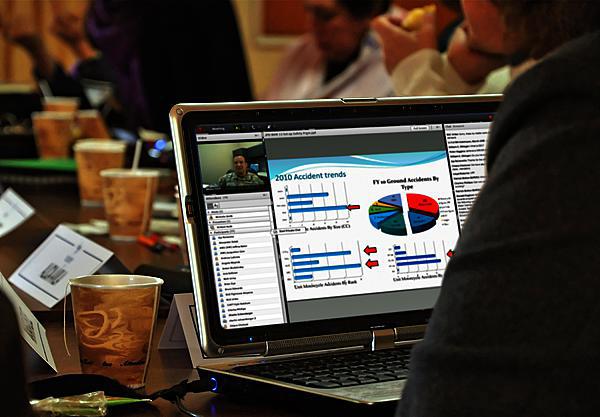No Venue, No Problem
The U.S. Navy uses a popular online collaboration tool to change course around last-minute travel restrictions.
The U.S. Naval Safety and Environmental Training Center, charged with conducting safety and environmental training worldwide, successfully is circumventing hurriedly imposed government travel restrictions by using an online application to conduct safety and environmental training. The tool recently enabled the center to conduct an annual conference with more than 1,000 attendees.
Normally used for smaller meetings, the Adobe Connect software, which operates in the cloud environment, is readily available to the entire U.S. defense community through the Defense Information Systems Agency’s (DISA’s) Defense Connect Online (DCO).
“We execute an annual joint occupational safety and health conference,” explains Cmdr. Greg Cook, USN, commanding officer, U.S. Naval Safety and Environmental Training Center (NSETC) in Norfolk, Virginia. “We have members of all five services ... active duty military as well as civilians across the services.” The conference has been offered annually for the past 20 years, with venues alternating each year between Norfolk and San Diego.
The 21st Annual Joint Safety and Occupational Health Professional Development Conference (PDC) was to have been held in San Diego in March of this year, but planning for the meeting began to unravel when the U.S. Defense Department issued what Cmdr. Cook describes as “aggressive expenditure reductions and travel restrictions” on January 10. Cmdr. Cook explains that as his office was continuing to plan for this year’s PDC during most of last year, senior managers in both the U.S. Navy and the Defense Department began issuing new rules and regulations affecting travel and conferences. “One of the policy changes was that if you were going to hold a conference, you had to go through a request package process, including itemized financial analysis for your conference, and why it was more economical to do it within [the Defense Department], as opposed to doing it on the outside,” he explains. The review process took between six and nine months, and at first, the undersecretary of the Navy cleared Cmdr. Cook’s center to hold the PDC in San Diego.
However, simultaneously the Defense Department continued to issue additional travel and meeting regulations. Less than three months before the PDC, Cmdr. Cook and his staff had a problem, because while his conference had been approved, travel for those attending the meeting had just been scuttled.
“Even though we’d been approved, we had a thousand attendees registered, and 700 of those usually travel to the meeting, I didn’t see that we would have the same return on investment because few if any of those folks would be able to travel from around the globe to San Diego,” he relates.
As he was making the decision to cancel the brick-and-mortar conference, Cmdr. Cook began to consider whether the meeting might be held virtually. “My command has experience doing virtual and online training. When we began to see travel and training restrictions coming about 18 months ago, we began to convert some of our classes into an online format,” he says, expanding online training offerings beyond PowerPoint demonstrations and simple Web video. The new format of training now includes one-hour, real-time sessions supported by the DCO, an online meeting and collaboration tool the military uses and DISA operates.
At the heart of the DCO is Adobe Connect, an application based on the Flash applet and Microsoft’s SQL database software. Adobe Connect originally had been developed by Presedia Publishing Systems and Macromedia, before Adobe acquired the latter company. The software is used to create information and general presentations, online training materials, Web conferencing, learning modules and user desktop sharing.
Within a few days of cancelling the San Diego PDC, the commander contacted a DISA program management team to inquire about using DCO to facilitate the safety conference. “We said, ‘We expect 1,000 attendees; we have about 80 seminars; and we’ll need dozens of meeting rooms.’ They informed us that at the time, it was not feasible to conduct the conference on DCO.mil because we were exceeding its capacity,” he recalls. DISA did say, however, that they had an alternative.
“DCO Cloud is on the GSA Schedule, so we were able to purchase DCO Cloud to execute the conference,” he says. DISA had been quietly doubling capacity for concurrent users of DCO since late 2012 to meet increasing demand for the service, and most of the expansion of DCO capacity had been completed by late January.
Cmdr. Cook stresses that he remained focused on holding the meeting virtually during the originally scheduled week in March, “because everybody had already scheduled that week off, and our speakers had already scheduled the time, and I thought that sticking to that schedule would help our attendance—and it did.” With four weeks to go before the start of the conference, his command completed acquisition of DCO Cloud, and with three weeks to go, it began preparations for the conference, which included training his staff how to support the application in a conference mode. Two weeks prior to conference start, DISA and Adobe pushed the conference site live, and NSETC began to upload the speaker’s presentations and other materials for the online PDC.
Even though NSETC was experienced using DCO in smaller training classes, Cmdr. Cook acknowledges that he was taking a significant risk in using DCO Cloud for something as big as the safety conference. However, he continues, “We were pretty comfortable with using the technology, and that reduced my risk—somewhat.”
The commander believes that another important factor in the success of the conference was preserving much of the look and feel of the meetings that had occurred in the past 20 annual conferences. “Our agenda, our presentations and much of what we give during a normal meeting we retained during the virtual conference for the people who attend the conference year in and year out.”
Cmdr. Cook says a second priority was finding ways to adapt some physical requirements of conference seminars to the virtual meeting environment. “In some cases at our conferences, we had presentations that included physical mock-ups, large physical objects or they had sessions where people broke out into teams and sessions where we had assessments or exams,” he explains. In that case, NSETC worked to reduce the number of seminars with those requirements, reducing the total number of seminars to 50 for the virtual conference.
The DCO also allowed Cmdr. Cook to focus on user engagement during the conference. “One limitation of the virtual conference is that you don’t have the face-to-face interaction that you have at a brick-and-mortar conference. Communication can be unnatural and can leave people wondering how to interact with peers when they couldn’t see them in the rooms,” he explains.
The answer came in the form of tools that conference managers could use to engage virtual attendees.“There are polling questions; DCO gives us a chat feature; and it gives a file sharing feature. So, we can share the presentations and give everyone an electronic copy instead of paper,” he says.
Polling questions also enabled NSETC to ask attendees questions and allow them to vote. “Our speakers could then provide follow-up to ensure that the message that they presented was communicated successfully,” the commander explains. This created an opportunity for a form of engagement that would normally not have taken place at the brick-and-mortar PDC, he adds.
The chat feature also makes possible a different kind of question-and-answer session. Attendees could ask questions using the chat pod, as it is called, throughout the presentation. “What we began to see was that presenters would begin to answer some of those questions as they went through their slides,” Cmdr. Cook explains. This capability expanded the number of questions that could be answered during a seminar, he adds. The questions and the responses became a part of the conference archive, which is stored with the audio and video of the presentations, as well as the presenters’ slide decks, handouts and other seminar content.
For logistical reasons, most of the conference took place in real time, and the sessions were not made available for on-demand viewing until after the conference ended. As a result, the majority of attendees were from the Eastern and Central time zones of the United States, with more West Coast attendees joining around lunchtime. Cmdr. Cook also notes that for the first time, the PDC had significant attendance from Hawaii, Guam, Japan, Singapore and Germany. “Some of those folks were up until midnight, and two or three in the morning in Guam and Japan, participating in our conference,” he notes. Seminar attendance ranged from 30 to 200 people per session, and among the 80 speakers, one presented material from his location in Japan.
At past safety conferences, attendance in Norfolk and San Diego ranged between 750 and 1,200 people; for the virtual PDC, Cmdr. Cook says the 2013 NSETC had 1,500 paid registrants, which “is more than we had in the previous 20-year history of the meeting.”
However, measuring actual attendance at a virtual meeting is different from a face-to-face conference, he stresses. “We know that we had over a thousand people attend. In the past, we would have people fly in, grab their name badge and we knew who they were. At the virtual conference, the majority of people would attend from their desk, but in some places, we had people attending from their conference room where they had two or three people with them and in some cases as many as five or six,” he explains, adding that he now considers attendance the highest in the 21-year history of the safety conference. In addition, the DCO metrics show that 600 people attended the conference general sessions, which included speeches from military officers, civilians from the Senior Executive Service and “everything but the color guard,” he quips. “I was here in Norfolk, and I spoke, and my admiral spoke. We had speakers from the Pentagon. We had a general speak from New Mexico.”
Cmdr. Cook says the virtual capabilities of the DCO also proved to be a lifesaver for the conference when it came to the conference’s keynote speaker, Janet Froetscher, president and CEO of the National Safety Council. “She was in Chicago, and I met her the night before over the webcam on the desk at her office, and we were all set to go. And then she said, ‘I don’t know if you heard, but we’re expecting nine inches of snow. I’m concerned that I won’t be able to get into my office and present tomorrow.’” He asked whether her home computer was equipped with a webcam, and when she answered yes, Cmdr. Cook told her she could deliver the keynote from home. Froetscher called into the conference moderator the next morning and confirmed she was snowed in. “She spoke to 600 people who had joined the conference from around the world from her living room in the middle of a snowstorm.”
In addition, he notes that one of his attendees was a safety officer on board an aircraft carrier. “He had a little trouble with bandwidth issues, but that’s because he was connecting from a ship underway,” he says.
Asked if he would consider doing the annual safety conference online in the future, Cmdr. Cook says he would. “I don’t think this is a solution for every conference out there,” he candidly admits, “but it can be successful for some conferences.” He believes the money saved by conducting conferences virtually will allow the Defense Department to continue to offer essential meetings in the future. He also is confident that more can be done within the DCO to create additional opportunities to replace the face-to-face interaction that is sometimes the most valuable aspect of brick-and-mortar conferences.





Comments